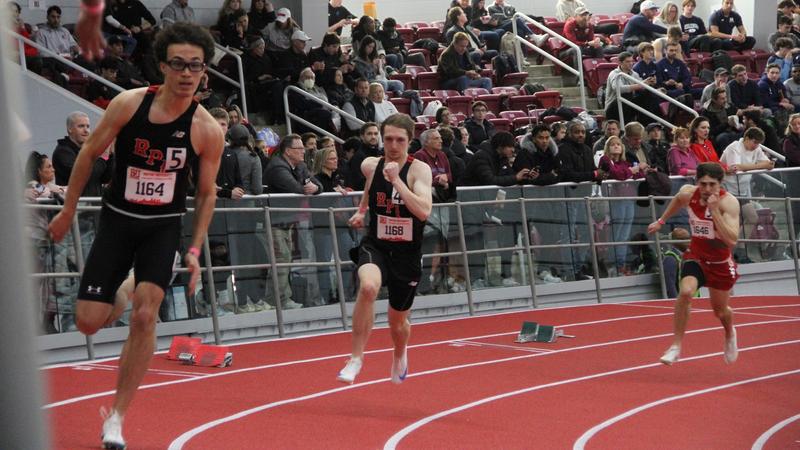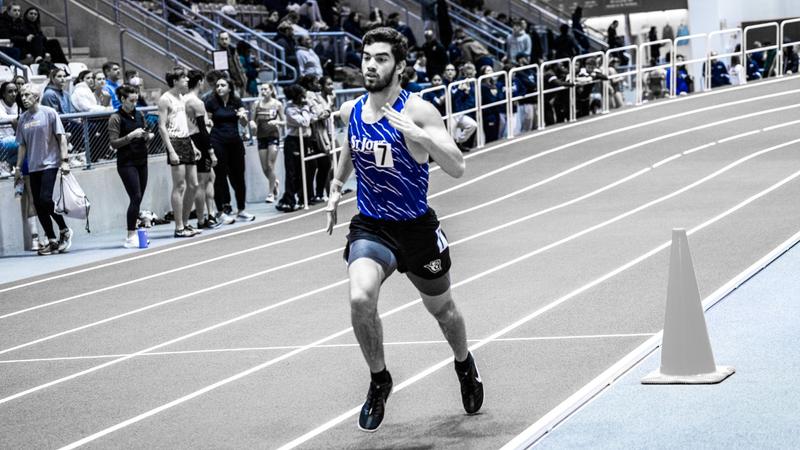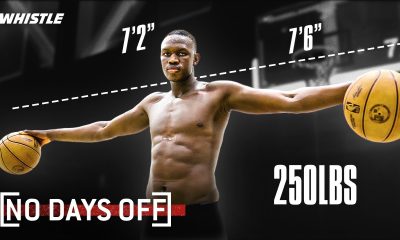Sports
Game on for Union High esports team



Sports
Track and Field Competes at Art Kadish Elm City Challenge: Zacarolli Sets School Heptathlon Record

RESULTS
NEW HAVEN, Conn. | The Farmingdale State College indoor track and field teams competed Friday and Saturday at the Art Kadish Elm City Challenge, with the Rams’ men’s squad placing fourth (49 points) behind a winning, school-record performance in the heptathlon by freshman Ethan Zacarolli (Hillsdale, N.Y.), while the women’s contingent tied for 10th place.
Zacarolli won the men’s heptathlon with a score of 4,550 points, which topped the previous FSC record of 4,038 points set by Nicholas Lourenco in 2023.
Also pacing the Rams’ efforts were freshmen jumpers Jaden Cesar (Queens, N.Y.) and Christian Destine (Rosedale, N.Y.). Cesar’s leap of 13.48 meters (44-2.75) in the triple jump was good for third place, while Destine’s long jump of 6.69m (21-11.5) placed fifth.
On the women’s side, junior pole vaulter Mishell Delgado (Bronx, N.Y.) earned fifth-place points for Farmingdale State, clearing a height of 2.50 meters (8-0.25) on her second jump of the afternoon.
Farmingdale State is back in action during the new year on Saturday, January 10, when it travels to Middletown, Conn., for the Wesleyan Winter Invitational.
Sports
Men’s Track & Field Records 35 Top-8 Performances at Dartmouth December Invite

HANOVER, NH – The Rensselaer Polytechnic Institute (RPI) men’s track & field team produced a standout performance at the Dartmouth December Invite on Saturday, registering numerous top-five finishes across sprints, jumps, hurdles, and throws in an all-around strong showing in early-season competition.
RPI’s jumpers once again led the charge, starting with sophomore Oliver Herrick, who finished runner-up in both the high jump (1.80 meters) and triple jump (13.53 meters). In the high jump, Herrick was joined by senior Calvin Chang in fourth place at 1.75 meters. The Engineers dominated the triple jump event, occupying four of the top five places. Senior Evan Boyd landed in third at 12.74 meters, followed by Jack Notaro in fourth (12.28m) and Caius Leung in fifth (12.06m).
In the horizontal jumps, Ervin Owusu claimed second in the long jump with a leap of 6.49 meters, while Dillen Owusu and Evan Boyd rounded out the scoring in fourth (6.12m) and fifth (5.98m), respectively. The pole vault squad also had a strong outing, as Shawn Keenan cleared 4.55 meters to place fifth and Moss Dengler added an eighth-place mark of 4.25 meters.
The Engineers’ sprint and hurdle groups delivered several high finishes in the short-distance races. In the 60-meter dash, five RPI athletes placed in the top eight: Alexander Flynn placed second in 7.19 seconds, just ahead of Jack Catelotti (3rd, 7.22), Francis Grasso (4th, 7.23), Gabe Sicurella (7th, 7.27), and Rafael Steiner (8th, 7.38). Flynn added a third-place finish in the 300 meters with a time of 36.31 seconds. Steiner and Catelotti followed closely in fifth (36.46) and sixth (36.66), with Grasso finishing eighth (36.86).
In the hurdles, Chris Kay ran 8.86 seconds to take third in the 60-meter hurdles, while John Bellini (4th, 9.28), Caius Leung (6th, 9.72), and Jack Currie (8th, 10.12) helped the Engineers control the finals heat. In the 500 meters, RPI had three athletes in the scoring group: Richard Biase (6th, 1:11.68), Jack Gips (7th, 1:11.96), and Samuel Aubut (8th, 1:11.97), all finishing within tenths of a second of one another.
RPI’s throwers were equally dominant in both the shot put and weight throw. In the shot put, Paul Sussman led the Engineers with a fourth-place throw of 13.42 meters. He was backed by Tristan Mangin (5th, 13.12m), Logan Gamlin (7th, 12.15m), and Arthur Hrycak (8th, 11.96m), giving RPI four of the top eight marks.
In the weight throw, Colby Grove recorded a third-place finish with a mark of 14.96 meters, with Sussman (4th, 14.66m), Max Fetah (5th, 14.62m), and Eric Mulqueen (6th, 14.58m) close behind in a tightly packed leaderboard.
Sports
Meyer takes down Central 60-meter hurdles record

IOWA CITY— At the Jimmy Grant Alumni Invitational hosted by the University of Iowa Saturday, Central College men’s track and field senior Gunner Meyer (senior, Fairbank, Wapsie Valley HS) broke the program’s all-time record in the men’s 60-meter hurdles.
Meyer clocked in at 7.92 seconds, the fastest time by any Division III athlete so far this season. He’s the first Dutch athlete to go under the eight-second mark. He placed third in the meet behind a pair of Hawkeyes.
Men’s triple jumper Kale Purcell (fifth year, Holton, Kan.) also matched the school record with a leap of 48 feet, 6 inches to win the meet.
Alivia Roerdink (junior, Tiffin, Ohio, Hopewell-Loudon HS) ran the second-fastest women’s 800 meters time in school history, crossing the line in 1 minute, 37.81 seconds. She placed fifth.
In the women’s 60-meter prelims, Ava Parkins (junior, Monmouth, Ill., Burlington Notre Dame HS [Iowa]) clocked in at 7.70 seconds to share second place on the program’s all-time list. It also makes No. 8 nationally. She didn’t run the finals after qualifying in seventh. She also finished third in the 300 meters in 39.55 seconds.
Mary Gustason (senior, Marion, Linn-Mar HS) was third in the women’s 200 meters in 26.10 seconds.
Central will reset after the student’s winter break with the Dutch Athletics Classic the next competition on January 16, 2026.
Sports
Hawks Women’s Track & Field Have Strong Showing at the SCSU Art Kadish Invitational

NEW HAVEN, Conn. – On Friday and Saturday, the University of Hartford men’s indoor track & field team competed in their first two-day meet of the season placing in 2nd out of 11 teams in the Art Kadish Invitational hosted by Southern Connecticut State University.
Rapid Recap:
- Senior Destinee Majett (Brick Township, N.J.) headlined the Hawks throwing for a massive personal best in the women’s weight throw taking second place hitting a distance of 15.09 meters. Majett moved to third all-time in the event in program history with the throw.
- Junior Jordan Murphy (East Hampton, Conn.) would also make her mark in the meet breaking the meet record for the pentathlon with a score of 3292.
- Senior Madison DiPasquale (Wallingford, Conn.) finished second in the women’s shot put event hitting 12.33 meters.
- Freshman Caroline McGinnis (Windsor Locks, Conn.) placed 8th in the women’s long jump at a distance of 4.85 meters.
- Freshman Jaya Pichay (South Windsor, Conn.) had a great showing in the 55 meter dash. Pichay finished the preliminaries in 4th place at a time of 7.47, before racing to a 5th place finish in the event at a personal best time of 7.43.
- Freshman Leah Valentino (Beacon Falls, Conn.) placed in first for the Hawks in the 600 meter at a time of 1:50.20.
- In the 55 meter hurdles event junior Caroline Crocker (Bernardston, Mass.) placed in second at a time of 8.48 seconds which was a new school record. Sophomore Tamara Greene (Hartford, Conn.) followed in fourth place at a time of 8.67 seconds.
- Freshman Maeve McGinnis (Windsor Locks, Conn.) scored points in the high jump competition coming in second clearing a height of 1.55 meters.
Up Next:
The Hawks will head to winter break returning to action on January 24th, competing at Wesleyan University.
For the latest information on Hartford Athletics follow the Hawks on Facebook, Instagram, X, and YouTube.
Sports
Saint Joseph’s Men Turn in Record Jumps and Relay Win at USM Alumni Open

GORHAM, Maine – The Saint Joseph’s College men’s track and field team turned in a statement performance at the USM Alumni Open on Saturday, highlighted by two school records from freshman standout Stephen Pierre, a relay victory, and multiple New England Division III qualifying marks in the jumps and hurdles.
“We brought great energy and effort today and were rewarded with some impressive marks. Our ability to cover events with talent and depth continues to grow and will be a key to our success at the conference level,” said Head Coach Mike Burleson.
“The caliber this group is competing at right now makes me incredibly proud,” added Associate Head Coach Troy Hendricks. “To be dropping school-record performances on just meet two of the season speaks to how bought-in they are. I’m excited to see the work they put in over winter break and where that momentum takes us when we come back at the start of the new year.”
SPRINTS AND RELAYS
Junior Jacob Schmader (Limington, Maine) and senior Noah Batoosingh (Scarborough, Maine) led a strong effort in the 300 meters, finishing third (36.82) and fifth (37.57), respectively, to pace the sprint group on the flat 200-meter oval.
Freshman Eli Benjamin (Rochester, N.H.) competed in the 55-meter dash, clocking 7.01 in the prelims to place ninth overall in a tight field.
Saint Joseph’s grabbed a win on the track in the 4×200-meter relay, as Batoosingh, sophomore John Read, freshman Eli Benjamin, and Schmader combined to run 1:34.17, crossing the line first and continuing the early-season momentum from the Elm City Classic.
In the 4×400-meter relay, the quartet of junior Aidan Mills (Ontario Center, N.Y.), sophomore Isaac Keresey (Pittsfield, Maine), junior Emilson Zoccolo (Lewiston, Maine), and sophomore Harrison Fields (Gray, Maine) placed second in 3:42.01, closing the meet with another strong relay showing for the Monks.
MID-DISTANCE AND DISTANCE
Senior Brayden Grant (Rochester, N.H.) turned in a solid performance in the 500 meters, placing fifth in 1:18.19.
In the 1000 meters, Mills led the way with a fourth-place finish in 2:55.79, followed by Fields in eighth at 3:03.49 and senior Kyle Benson (Biddeford, Maine) in ninth at 3:12.55, as the Monks continued to build depth through the middle-distance group.
Keresey posted one of the top distance marks of the day, finishing second in the mile with a time of 4:31.81, while Zoccolo added a 13th-place finish in 5:07.57.
In the 5000 meters, senior Jacob Pelletier (Augusta, Maine) clocked 16:04.76 to place fifth, and teammate Alexey Seredin (Peaks Island, Maine) ran 16:49.95 for 11th, giving Saint Joseph’s a strong presence in the longest event of the day.
HURDLES
The 55-meter hurdles proved to be a major highlight and a key event for the Monks.
Pierre, competing in his first collegiate hurdles meet, broke the school record and placed second in the final in 7.98, hitting the New England Division III provisional standard. Read followed in third at 8.01, also meeting the provisional standard, as the pair delivered a big 2–3 finish in the final.
The prelims were equally impressive, with Pierre (8.17), Read (8.21), and junior Tudum Monday (Lewiston, Maine) (8.24) all achieving New England Division III provisional qualifying times, giving Saint Joseph’s three hurdlers at championship-caliber level just two meets into the season.
JUMPS
Pierre produced another breakout performance in the long jump, where he broke his own school record and won the event with a mark of 6.81m (22′ 4.25″), an automatic qualifier for the New England Division III Championships. His series also included jumps of 6.78m and 6.71m, showcasing impressive consistency at a high level. Junior Devonte Prom (Portland, Maine) added a strong fifth-place finish at 5.75m (18′ 10.5″).
In the triple jump, Monday won the event with a mark of 13.03m (42′ 9″), good for a New England Division III provisional qualifying performance. Junior Christopher Godefroy (Windsor Locks, Conn.) placed fifth at 11.64m (38′ 2.25″), while Peters finished seventh with a best of 10.96m (35′ 11.5″).
In the high jump, Benjamin continued his strong start by clearing 1.83m (6′ 0″) for second place, while sophomore Martinho Codo (Lewiston, Maine) jumped 1.73m (5′ 8″) to finish fourth.
THROWS
The Monks’ young and deep throws group continued to gain momentum across both the shot put and weight throw.
In the shot put, sophomore Anthony Vasquez (Westbrook, Maine) led the way with a ninth-place finish at 10.07m (33′ 0.5″), followed by senior Alexander Greslick (Windham, Maine) in 10th at 9.80m (32′ 2″). Freshman Brandt Bishop (Marblehead, Mass.) threw 9.10m (29′ 10.25″), classmate Daven Duquette (Berlin, N.H.) recorded 9.07m (29′ 9.25″), and fellow freshman Cameron Gonyer (Berlin, N.H.) added a mark of 7.99m (26′ 2.75″). Junior Gabryel Balch (Strafford, N.H.) rounded out the group at 7.31m (23′ 11.75″).
In the weight throw, Vasquez placed fifth with a throw of 9.75m (32′ 0″), Gonyer finished sixth at 9.73m (31′ 11.25″), and Duquette took seventh with 9.60m (31′ 6″). Greslick added an eighth-place mark of 9.48m (31′ 1.25″), while Balch finished 10th at 9.09m (29′ 10″), giving Saint Joseph’s five athletes over nine meters and valuable early-season depth in the event.
FULL RESULTS
Men’s 55 Meters
Men’s 300 Meters
Men’s 500 Meters
Men’s 1000 Meters
Men’s 1 Mile Run
Men’s 5000 Meters
Men’s 55-Meter Hurdles (Prelims)
Men’s 55-Meter Hurdles (Finals)
Men’s 4×200-Meter Relay
-
Batoosingh, Read, Peters, Schmader – 1:34.17 (1st)
Men’s 4×400-Meter Relay
-
Mills, Keresey, Zoccolo, Fields – 3:42.01 (2nd)
Men’s High Jump
Men’s Long Jump
Men’s Triple Jump
Men’s Shot Put
Men’s Weight Throw
Sports
Monks Women Sweep Relays, Break Three School Records at USM Alumni Open

GORHAM, Maine – The Saint Joseph’s College women’s track and field team continued its impressive start to the 2025-26 indoor season at the USM Alumni Open on Saturday, collecting three school records, three event victories on the track, and three New England Division III provisional qualifying performances.
“We brought great energy and effort today and were rewarded with some impressive marks. Our ability to cover events with talent and depth continues to grow and will be a key to our success at the conference level,” said Head Coach Mike Burleson.
“The caliber this group is competing at right now makes me incredibly proud,” added Associate Head Coach Troy Hendricks. “To be dropping school-record performances on just meet two of the season speaks to how bought-in they are. I’m excited to see the work they put in over winter break and where that momentum takes us when we come back at the start of the new year.”
SPRINTS AND RELAYS
The Monks showed depth in the short sprints, advancing two to the final in the 55 meters. Sophomore Ellie Leech (Berwick, Maine) and freshman Emma Jones (Poland, Maine) finished seventh (8.08) and eighth (8.09), respectively, after running 8.02 (Leech) and 7.98 (Jones) in the prelims. Junior Alexis Cowan (Nottingham, N.H.) clocked 8.07, freshman Kaitlin Tallman ran 8.13, and first-year Hallye King (Owls Head, Maine) posted 8.31 to round out a strong preliminary group.
In the 200 meters, freshman Olivea Miller (Livermore Falls, Maine) placed second in 27.37, hitting the New England Division III provisional standard, while Jones added a seventh-place finish in 28.87.
The Monks swept both relays on the day. In the 4×200-meter relay, the quartet of Audrey Bilodeau (Lewiston, Maine), Ava Smart (South Portland, Maine), Jones, and Tallman posted a winning time of 1:53.49. The 4×400-meter relay of Bella Koepsell (Falmouth, Maine), Alexia Young (Rochester, N.H.), Cheri Willems, and Amber Pendleton (Warren, Maine) closed the meet with another victory, clocking 4:30.61.
MID-DISTANCE AND DISTANCE
Freshman Amber Pendleton continued her strong start to the season with a school-record performance in the 500 meters, winning the event in 1:27.86. Willems followed with a third-place finish in 1:34.57, giving Saint Joseph’s two of the top three spots.
In the 300 meters, junior Ava Smart broke the school record, placing third in 44.07, just ahead of Bilodeau, who finished fourth in 44.86.
Senior Alexia Young collected a runner-up finish in the 1000 meters, posting a time of 3:31.00, while Koepsell ran to second place in the mile in 5:48.35.
HURDLES
Sophomore Madalyn Guindon (Saco, Maine) turned in a solid performance in the 55-meter hurdles, placing fourth in 10.60 to add more points for the Monks’ track group.
JUMPS
The vertical and horizontal jumps again proved to be a strength for Saint Joseph’s.
In the high jump, Miller cleared 1.47m (4′ 9.75″) to finish second, while junior Breya Whitman (Auburn, Maine) cleared 1.37m (4′ 6″) for fifth.
The long jump saw Cowan lead the way with a seventh-place finish at 4.74m (15′ 6.75″). Sophomore Olivia Bean (South Portland, Maine) followed in eighth at 4.68m (15′ 4.25″), while Tallman placed 13th (4.55m / 14′ 11.25″). King (3.97m / 13′ 0.25″) and junior Samira Mohamed (Westbrook, Maine) (3.59m / 11′ 9.5″) rounded out the Monks’ long jump contingent.
Bean and sophomore Ella Labrie (Gorham, Maine) powered a huge day in the triple jump, combining for a 1–2 finish and two championship-caliber marks. Bean won the event with a school-record leap of 10.72m (35′ 2″), hitting the New England Division III provisional standard, while Labrie took second at 10.65m (34′ 11.25″), also surpassing the provisional mark.
THROWS
Leech led the Monks in the shot put with a best of 10.19m (33′ 5.25″), followed by sophomore Jemima Kabangu at 9.72m (31′ 10.75″). Freshman Grace Cunningham (Burnham, Maine) threw 8.71m (28′ 7″), and junior Haley Lang recorded a mark of 7.99m (26′ 2.75″).
Cunningham highlighted the weight throw with a 10.74m (35′ 3″), while Lang added a mark of 7.77m (25′ 6″) as the Monks’ throwers continued to build on their early-season progress.
FULL RESULTS
Women’s 55 Meters
-
Emma Jones – 7.98 (prelims, 7th) / 8.09 (finals, 8th)
-
Ellie Leech – 8.02 (prelims, 8th) / 8.08 (finals, 7th)
-
Alexis Cowan – 8.07 (prelims, 9th)
-
Kaitlin Tallman – 8.13 (prelims, 10th)
-
Hallye King – 8.31 (prelims, 13th)
Women’s 200 Meters
Women’s 300 Meters
Women’s 500 Meters
Women’s 1000 Meters
Women’s Mile
Women’s 55-Meter Hurdles
Women’s 4×200-Meter Relay
-
Bilodeau, Smart, Jones, Tallman – 1:53.49 (1st)
Women’s 4×400-Meter Relay
-
Koepsell, Young, Willems, Pendleton – 4:30.61 (1st)
Women’s High Jump
Women’s Long Jump
Women’s Triple Jump
-
Olivia Bean – 10.72m (35′ 2″) (1st, school record, NE DIII provisional)
-
Ella Labrie – 10.65m (34′ 11.25″) (2nd, NE DIII provisional)
Women’s Shot Put
Women’s Weight Throw
-
Grace Cunningham – 10.74m (35′ 3″) (13th)
-
Haley Lang – 7.77m (25′ 6″) (19th)
-

 Rec Sports3 weeks ago
Rec Sports3 weeks agoFirst Tee Winter Registration is open
-

 Rec Sports2 weeks ago
Rec Sports2 weeks agoFargo girl, 13, dies after collapsing during school basketball game – Grand Forks Herald
-

 Motorsports3 weeks ago
Motorsports3 weeks agoCPG Brands Like Allegra Are Betting on F1 for the First Time
-

 Motorsports3 weeks ago
Motorsports3 weeks agoF1 Las Vegas: Verstappen win, Norris and Piastri DQ tighten 2025 title fight
-

 Sports3 weeks ago
Sports3 weeks agoTwo Pro Volleyball Leagues Serve Up Plans for Minnesota Teams
-

 Sports3 weeks ago
Sports3 weeks agoUtah State Announces 2025-26 Indoor Track & Field Schedule
-

 Sports3 weeks ago
Sports3 weeks agoSycamores unveil 2026 track and field schedule
-

 Motorsports2 weeks ago
Motorsports2 weeks agoJo Shimoda Undergoes Back Surgery
-

 Motorsports2 weeks ago
Motorsports2 weeks agoRedemption Means First Pro Stock World Championship for Dallas Glenn
-

 Sports3 weeks ago
Sports3 weeks agoTexas volleyball vs Kentucky game score: Live SEC tournament updates






















































